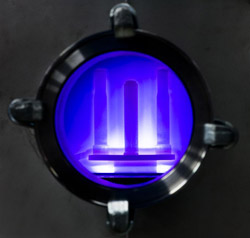Processed tubes prevent the risk of thrombosis

Plasma chamber<br>Copyright: Bellhäuser<br>
Small artificial tubes in the veins, so-called stents, dilate the veins and allow the blood to circulate again without hindrance.
But after a while, the deposit of cells and blood components starts at these tubes, as well, and thus the blood vessel narrows again. In an international joint project, scientists from Saarbrücken are now investigating the feasibility, how to change the surface of these tubes so that no unwanted components may no longer be deposited there.
Under the auspices of INM — Leibniz Institute for New Materials, scientists are working on coating processes that smooth the tube walls and make them well tolerated for the human body. The kick-off meeting of the joint project Nano4stent took place at INM at the beginning of January, bringing together the joint partners of INM, the Saarland University Hospital Homburg, the Kocaeli University/Turkey, and the Korean University of Technology and Education/Korea. The joint project Nano4stent is funded by the EU in the framework of the international cooperation network KORANET.
The scientific experts at INM use a special method in their research work: In the same way as water drops from vapor are formed uniformly on the cold lid of a pot, the researchers form the coating on the surface of the tube. “It is our aim to cover the surface of the tubes with a completely even protection layer”, says Cenk Aktas, head of the program division “CVD/Biosurfaces”. For this purpose, small cavities will be applied synthetically on the surface by using laser treatment. After each cavity and the whole surface of the tubes is perfectly coated, the unwanted components will no longer have a chance to react with the surface of the tube and to adhere there.
INM is focused on the research and development of materials – for today, tomorrow and the future. Chemists, physicists, biologists, materials and engineering scientists shape the work at INM. From molecule to pilot production, they follow the recurring question: Which material properties are new, how can they be investigated and how can they be used in the future?
The INM — Leibniz Institute for New Materials, situated in Saarbrücken/Germany, is an internationally visible center for materials research. It cooperates scientifically with national and international institutes and develops for companies throughout the world. INM is an institute of the Scientific Association Gottfried Wilhelm Leibniz and employs around 190 collaborators. Its main research fields are chemical nanotechnology, interface materials and materials in biology.
Contact:
Dr. Cenk Aktas
INM — Leibniz Institute for New Materials
Phone: +49 681 9300 140
E-mail: cenk.aktas@inm-gmbh.de
Media Contact
More Information:
http://www.inm-gmbh.deAll latest news from the category: Health and Medicine
This subject area encompasses research and studies in the field of human medicine.
Among the wide-ranging list of topics covered here are anesthesiology, anatomy, surgery, human genetics, hygiene and environmental medicine, internal medicine, neurology, pharmacology, physiology, urology and dental medicine.
Newest articles

A universal framework for spatial biology
SpatialData is a freely accessible tool to unify and integrate data from different omics technologies accounting for spatial information, which can provide holistic insights into health and disease. Biological processes…

How complex biological processes arise
A $20 million grant from the U.S. National Science Foundation (NSF) will support the establishment and operation of the National Synthesis Center for Emergence in the Molecular and Cellular Sciences (NCEMS) at…

Airborne single-photon lidar system achieves high-resolution 3D imaging
Compact, low-power system opens doors for photon-efficient drone and satellite-based environmental monitoring and mapping. Researchers have developed a compact and lightweight single-photon airborne lidar system that can acquire high-resolution 3D…





















